Note: This is part of a Research Update series that highlights projects funded by the California Department of Food and Agriculture’s (CDFA) Fertilizer Research and Education Program (FREP) Grant Program.
Project Title: Irrigation and Nitrogen Management, Monitoring, and Assessment to Improve Nut Production While Minimizing Nitrate Leaching to Groundwater
Project Leaders:
- Dr. Thomas Harter, Professor and Cooperative Extension Specialist in Water Resources, UC Davis
- Dr. Patrick Brown, Professor of Plant Sciences, UC Davis
- Dr. Isaya Kisekka, Professor of Hydrology and Agricultural Water Management, UC Davis
Project Status: Completed
Location: Modesto, CA
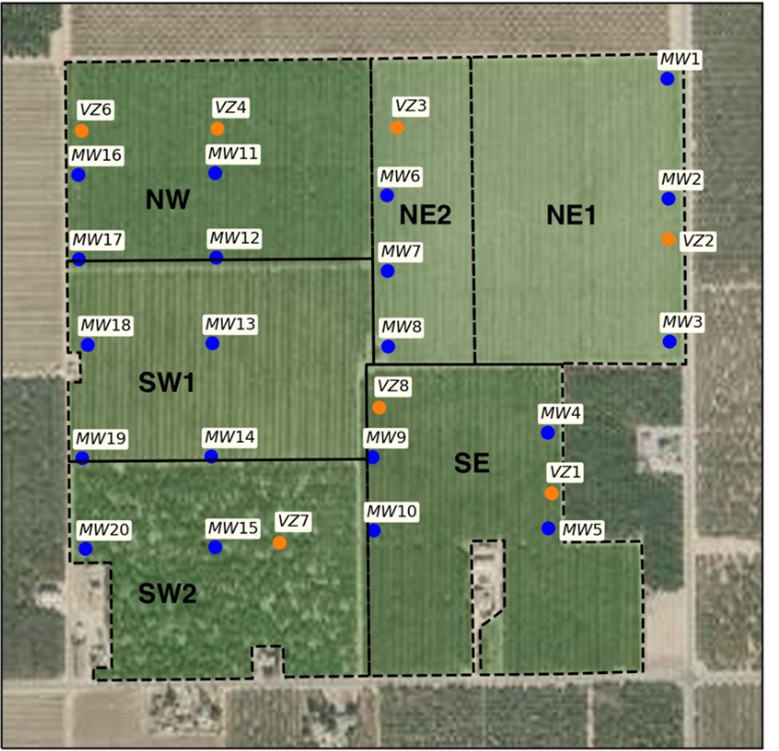
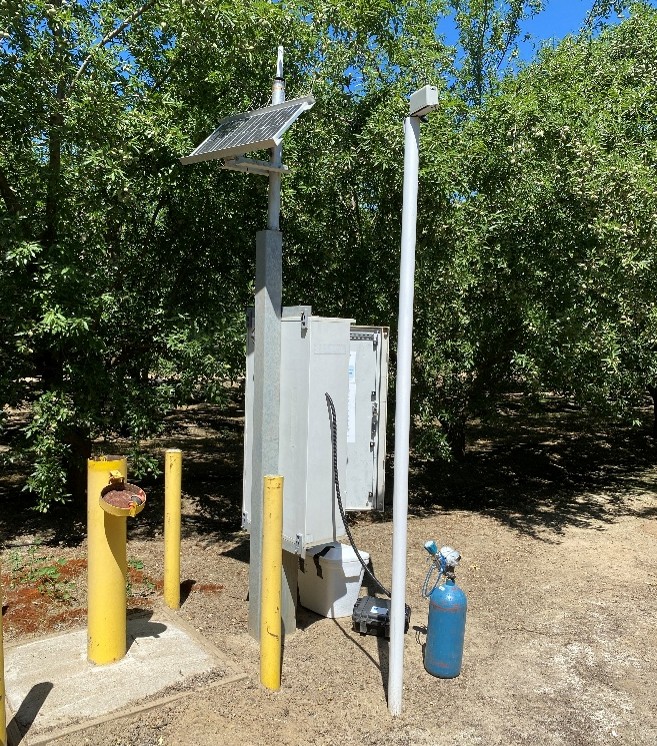
Left image: Modesto site and location of field instruments. Twenty groundwater monitoring wells (blue dots) and seven vadose zone monitoring stations (orange dots) were distributed throughout the 143 acre almond orchard. Right image: A groundwater monitoring site in the almond orchard.
Overview:
Groundwater contamination from nitrate leaching is a growing concern in California’s agricultural regions. In almond orchards, excess nitrogen (N) from fertilizers can move through the soil into groundwater, contributing to nitrate contamination. This study evaluated High-Frequency Low-Concentration (HFLC) fertigation, where trees receive N through each irrigation based on nutrient demand (i.e., spoon-feeding or continuous fertigation) as a best management practice (BMP) for reducing nitrate leaching while maintaining crop productivity. Using field monitoring, N mass balance tracking, and numerical modeling, the work assessed HFLC’s long-term impact on nitrogen use efficiency (NUE) and groundwater quality. In addition, the researchers implemented a month-long pilot Agricultural Managed Aquifer Recharge (AgMAR) experiment on a portion of the orchard. Using the array of sensors and fertigation records, the researchers studied nitrate movement into the shallow groundwater table to better understand the impact of AgMAR on groundwater nitrate concentrations.
Key Takeaways
- Reported NUE at the almond orchard site increased by 18%, kernel yields increased by 15%, and less N fertilizer was required when compared to the previous five years of pre-HFLC orchard management.
- Annual N fertilizer savings from adopting HFLC varied from 17% to 30%, which equates to estimates of $31,000 to as much as $50,000 saved over a 10-year period. This savings exceeds the cost associated with the automated fertigation system required to implement HFLC.
- Nitrogen storage in the first 2 feet of soil and pore-water nitrate concentrations in the vadose zone (measured in top 10 feet of soil) in the orchard decreased after HFLC adoption.
- Due to the small amount of recharge provided through average annual precipitation, combined with efficient irrigation management, nitrate transport through the soil to the water table is subject to travel times from years to decades. This delays the measurable impact of implementing HFLC on groundwater quality in the short-term despite measured nitrate reductions in the vadose zone.
- Vadose zone and groundwater modeling results showed long-term nitrate reductions, predicting a 45% decrease in N leaching from the vadose zone in response to HFLC and observable decreases in groundwater nitrate concentrations within 20 years.
- Tracking the fertilizer mass balance using detailed irrigation, fertilization, and crop yield data correlated well with observed groundwater nitrate concentrations and can provide a practical, cost-effective tool for estimating nitrate leaching.
- Preliminary scenario modeling indicated promise for AgMAR, coupled with HFLC, to improve groundwater nitrate concentrations over time.
Methods and Approach
Nitrogen mass balance
At the start of each growing season, the researchers collaborated with the grower to adjust fertilizer application rates based on both the grower’s yield predictions and their calculations for optimal N input. The total fertilizer amount was then distributed across as many applications as possible to maintain HFLC management. The grower’s final fertilization plan was determined through a two-step process: an initial harvest estimate in March, following bloom, and a refined estimate in late April, after fruit set and plant tissue analysis. This approach combined formal plant N content analysis with the grower’s experience and intuition regarding potential almond yield for the season.
The research tracked the corresponding land surface annual water and N fluxes into and out of the orchard (irrigation, applied fertilizer, evapotranspiration (ET), and N removed through harvest) at the orchard scale. The calculations, which include a calculation of N uptake based on harvested kernel weight, are effectively identical to the method used by growers to comply with the Irrigated Lands Regulatory Program (ILRP) Irrigation and Nutrient Management Plan (INMP) requirements.
Vadose zone monitoring
Root zone monitoring was conducted at seven vadose zone monitoring stations randomly distributed throughout the orchard. Soil moisture, nitrate, and ammonium fluxes were collected approximately every two weeks during the growing season, and approximately monthly in the winter months via:
- Five pore water samplers placed at depths of approximately 1 ft, 2 ft, 3 ft, 6 ft, and 9 ft to record vadose zone N concentrations
- Access tubes to 10 ft used for manual water content measurements at the same five depths using a neutron probe tool
- Twice annually, before and after the growing season, soil samples were taken from 0 ft – 1 ft and from 1 ft – 2 ft, at nine random locations in each of the five orchard blocks within the orchard farm and composited into three samples at each depth
Groundwater monitoring
At this site, wells were sampled twice quarterly at 20 monitoring wells (screened at 7-14 m below ground surface) across the almond orchard. The following parameters were measured at each sampling event:
- Groundwater depth
- Nitrate concentrations
- Water quality indicators, including pH, electrical conductivity, redox potential, and temperature
Agricultural Managed Aquifer Recharge (AgMAR) trial
In May 2022, an AgMAR experiment was conducted in the northeastern orchard block of the farm after removal and recycling of trees. The recharge event involved flooding three 0.17 acre recharge basins at the orchard for a period of 29 days, applying approximately 30 ft of water in each basin. Following the AgMAR event, groundwater samples were regularly collected from the wells directly downgradient from the flooded area to assess changes in nitrate concentrations.
Vadose and groundwater model development and calibration
Models using HYDRUS1D and MODFLOW were developed and calibrated with data from the three groundwater monitoring approaches to simulate N transport and predict how the observed reductions in nitrate leaching would translate to long-term changes in groundwater quality. In addition, the MODFLOW-based groundwater flow model was adapted to incorporate the AgMAR recharge event. This enabled a better understanding of the threshold at which applied water dilutes nitrate concentrations rather than mobilizing stored N, which can help to refine recommendations for future AgMAR applications. A detailed description of the data used in each model and the simulations that were run can be found in the final report.
Project Results and Discussion
HFLC fertigation increased NUE without yield loss
After HFLC adoption in 2018, measured NUE increased from 74% to 86% (92% if 2023 and 2024 are included), and modeled NUE improved from 76% to 84%. Fertilizer applications decreased from 220 lb-N/ac/yr to 190 lb-N/ac/yr and 170 lb-N/ac/yr (first five and seven years, respectively).
Yield, although variable from year to year, did not decline despite decreased fertilizer application rates. Prior to HFLC implementation (2013-2017), orchard farm annual yields averaged 2,190 lb/ac of kernels (149 lb N/ac). Average yield after HFLC from 2018 to 2022 increased to 2,460 lb/ac of kernels (167 lb N/ac. For the entire 2018 to 2024 period, average yields with HFLC increased slightly less to 2,320 lb/ac of kernels (158 lb N/ac).
HFLC provides significant savings in fertilizer cost
The adoption of HFLC fertigation also substantially reduced N fertilizer costs. After implementing HFLC, an N savings of nearly 17.5% (33 lb N/ac), on average, between 2018 and 2022, and over 30% (54 lb N/ac), on average, between 2018 and 2024, was observed. The savings on N fertilizer on 143 acres at $0.65/lb N amounts to $3,100 per year when averaged over five years or $5,000 per year when averaged over seven years. Over 10 years, this savings of $31,000 or $50,000, respectively, would far exceed the cost of the automated fertigation system that was installed to enable HFLC.
HFLC decreased soil and pore water nitrate
Post-harvest soil N storage in the upper 2 ft of soil decreased by 80%, from ~100 lbs-N/ac to ~20 lbs-N/ac, indicating a significant reduction (p-value < 0.01) in residual N available for leaching. Vadose zone pore water nitrate concentrations also showed a statistically significant downward trend (p-value < 0.05) from 2018-2024 (Figure 1). Both results are consistent with the N mass balance in that N losses, and therefore leaching concentrations, decreased under HFLC fertigation.
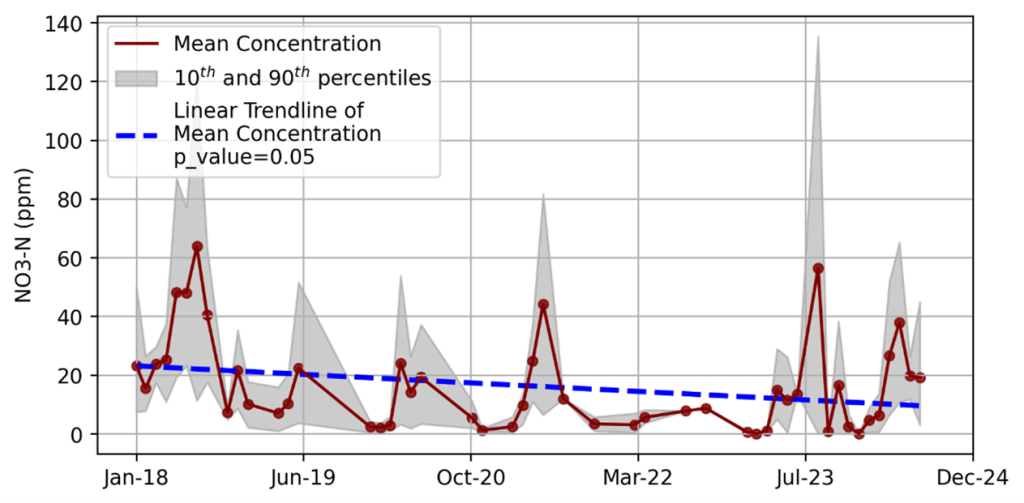
Figure 1: Vadose zone soil solution nitrate, measured in the suction lysimeter network from 0 – 2 ft (seven vadose zone monitoring stations).
HFLC causes long-term nitrate reductions over time
Vadose zone and groundwater modeling results indicate that HFLC fertigation will lead to meaningful improvements in groundwater nitrate concentrations over time. Vadose zone model simulations showed that nitrate concentrations leaching from the root zone to the water table decreased substantially following HFLC adoption. Prior to HFLC, modeled nitrate concentrations at the water table peaked at 47 mg/L NO₃-N, but under HFLC, these values declined to an average of 26 mg/L NO₃-N, representing a 45% reduction in nitrate loading over approximately 10 years (Figure 2). This decrease was driven by both improved NUE and reduced fertilizer application rates.
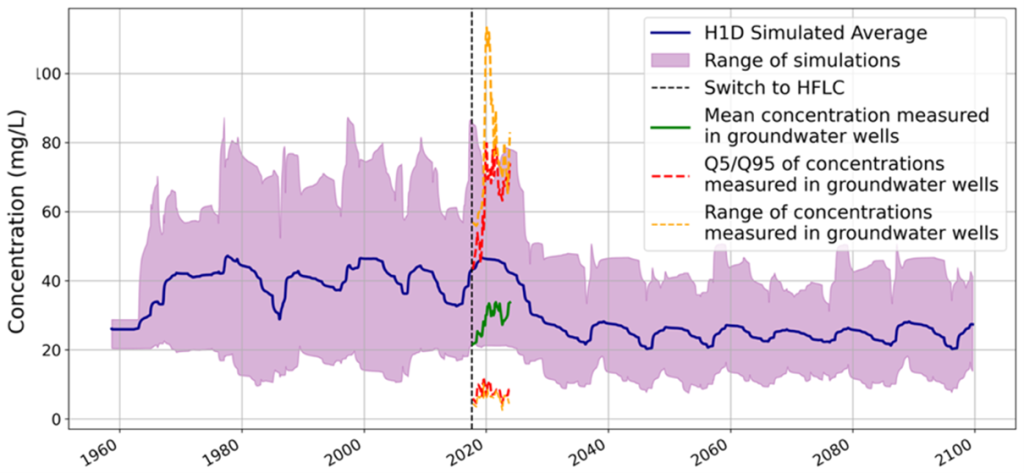
Figure 2: Mean and range of simulated nitrate-N concentration in recharge at the water table, 20 ft below ground surface (mean over 20 simulated locations within the orchard, one at each monitoring well site, honoring the observed stratigraphy) under pre-2018 management practices and with HFLC from 2018 onward. Measured concentrations in shallow groundwater monitoring wells are shown for 2017 – 2024 (total range, 5th and 95th percentile, mean). Simulated results for recharge nitrate are taken from the calibrated vadose zone model (Version 2024, Jordan et al., 2024). The calibrated vadose zone model assumed no nitrate in the vadose zone in 1960 and pre-HFLC water and N management (as measured by the grower in 2013-2017) over the entire pre-2018 simulation period. Results show that it takes approximately five years for the mean nitrate in recharge at the water table to begin to increase and about 10-15 years for the full effect of nitrate losses to be realized in recharge at the water.
Groundwater modeling showed that as older nitrate-laden water is gradually replaced by lower-nitrate recharge from HFLC-managed areas, overall groundwater quality is projected to improve. This will lead to measurable reductions in the upward trend in nitrate concentrations that have been observed, which is expected to peak and begin decreasing over the next decade. Variability in response is expected, particularly in areas with historically high nitrate leaching or recent tree replanting, where longer travel times may delay observable reductions. However, despite these localized differences, model results support HFLC fertigation as a viable solution for reducing agricultural nitrate loading to groundwater, with both measured and modeled data confirming its effectiveness in improving NUE and reducing nitrate losses.
Mass balance approach provides scalable alternative for estimating nitrate leaching
One of the main objectives of this project was to evaluate if the mass balance approach, which is currently used by growers when submitting INMP worksheets, can accurately estimate nitrate leaching losses. Results comparing mass balance to field data showed that block-level NUE tracking and a properly constrained mass balance approach using detailed irrigation, fertilization, and crop yield data, correlated well with observed groundwater nitrate concentrations. Blocks with higher estimated N leaching from the mass balance consistently exhibited higher groundwater nitrate concentrations, reinforcing the link between fertilizer application rates and long-term nitrate loading to the aquifer. This trend persisted across multiple years and climate conditions, demonstrating that orchard N management is the primary driver of nitrate concentrations in shallow groundwater.
Thus, the mass balance approach was found to be a viable and cost-effective alternative for estimating N leaching where direct measurements are impractical or cost prohibitive. While this method could not capture sub-block scale spatial variability, it effectively estimated average N leaching rates at the orchard block and orchard farm scale.
Initial AgMAR trial provides preliminary data on groundwater quality impacts
Results from a pilot study showed that when AgMAR was implemented (30 ft of recharge in one month), nitrate concentrations in the downstream wells were reduced in the short-term, although a rebounding effect was observed. However, repeating the practice over time led to substantial long-term (multi-year) reductions in groundwater nitrate concentrations. For example, applying the results of the AgMAR study to a scenario with repeated winter AgMAR treatments done once a decade showed long-term benefits to groundwater quality (Figure 3). Results will be further evaluated to develop guidance on larger-scale application of AgMAR under various common water availability scenarios in a future FREP project that will begin in January 2026.
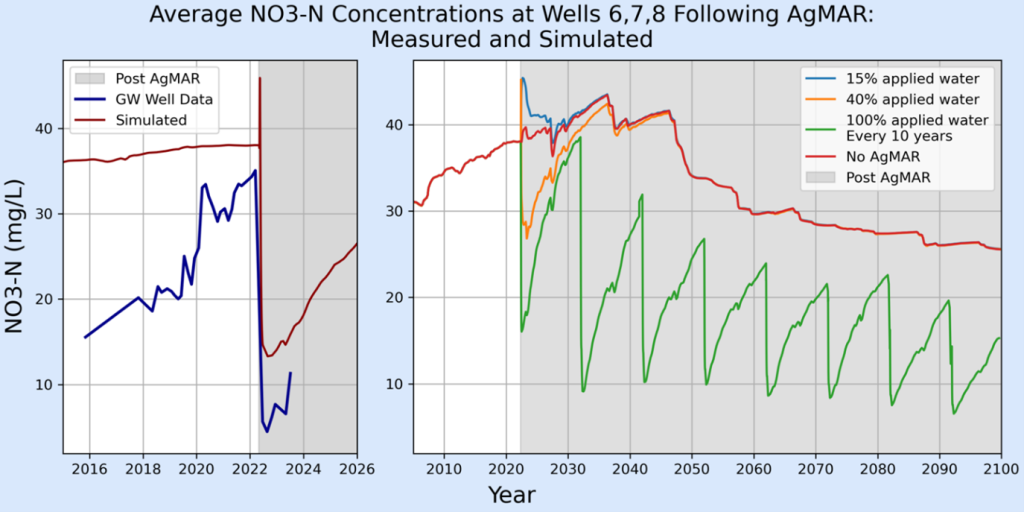
Figure 3: Scenario modeling of the AgMAR flooding that occurred at the orchard in the summer of 2022. The panel to the left shows the measured and simulated nitrate concentrations at the three wells directly below the AgMAR basins. The figure to the right shows the long-term concentrations in those wells out to the year 2100. The 15% and 40% applied water scenarios refer to applying that fraction of the amount applied in the actual experiment (10 ac ft/ac) across the entire orchard (1.5 ft and 4 ft). The green time series shows a scenario of flooding 100% of the actual applied water every 10 years.
Impact and Outreach
This project successfully demonstrated multiple benefits of the HFLC nutrient management practice for almond production, including stabilized or increasing yields, a decreased need for fertilizer, and an improvement in long-term groundwater quality by nearly 50%.
Over the project reporting period (2020-2024) and in the first half of 2025, the principal investigator and project team presented on this project at 76 events, reaching an estimated 3,000 attendees. The audience included growers, grower consultants, environmental consultants, extension advisors, academics, staff members of NGOs, policy and advisory groups, and decision-makers at the regional, state, and federal levels.
To learn more about this project and other current and completed FREP projects please visit: https://www.cdfa.ca.gov/is/ffldrs/frep/Research.html.


